2017 MITSUBISHI iMiEV light
[x] Cancel search: lightPage 245 of 296
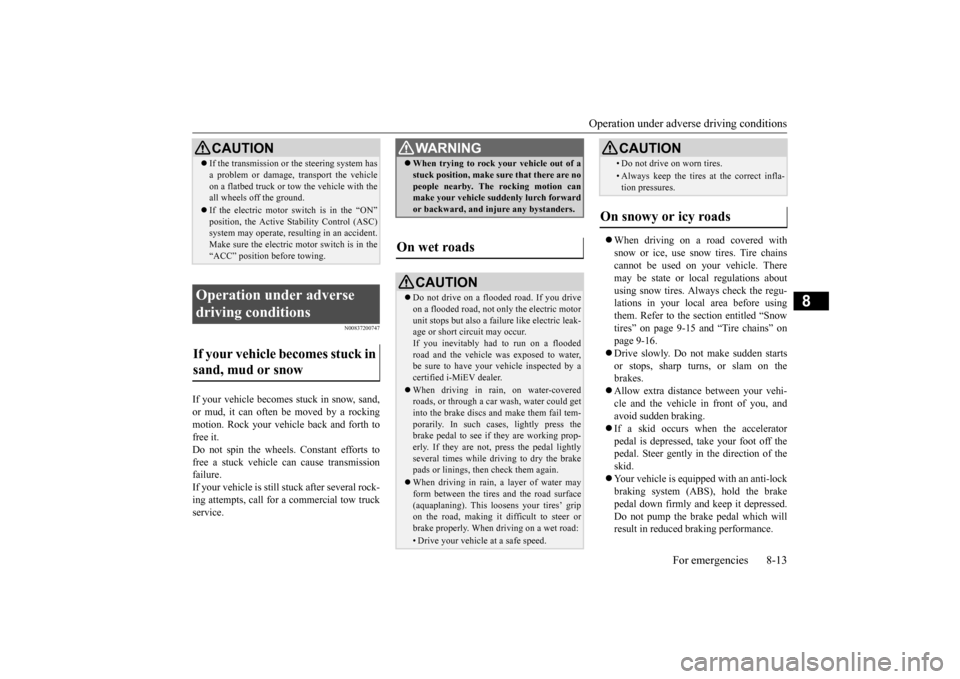
Operation under adverse driving conditions
For emergencies 8-13
8
N00837200747
If your vehicle becomes stuck in snow, sand, or mud, it can often be moved by a rocking motion. Rock your vehicle back and forth tofree it. Do not spin the wheels. Constant efforts to free a stuck vehicle can cause transmissionfailure. If your vehicle is still
stuck after several rock-
ing attempts, call for a commercial tow truckservice.
When driving on a road covered with snow or ice, use snow tires. Tire chains cannot be used on your vehicle. Theremay be state or local regulations about using snow tires. Always check the regu- lations in your local area before usingthem. Refer to the section entitled “Snow tires” on page 9-15 and “Tire chains” on page 9-16. Drive slowly. Do not make sudden starts or stops, sharp turns, or slam on the brakes. Allow extra distance between your vehi- cle and the vehicle in front of you, and avoid sudden braking. If a skid occurs when the accelerator pedal is depressed, take your foot off the pedal. Steer gently in the direction of theskid. Your vehicle is equippe
d with an anti-lock
braking system (ABS), hold the brakepedal down firmly and
keep it depressed.
Do not pump the brake pedal which will result in reduced braking performance.
CAUTION If the transmission or the steering system has a problem or damage,
transport the vehicle
on a flatbed truck or to
w the vehicle with the
all wheels off the ground. If the electric motor switch is in the “ON”
lting in an accident.
Make sure the electric motor switch is in the“ACC” position before towing.
Operation under adverse driving conditions If your vehicle becomes stuck in sand, mud or snow
WA R N I N G When trying to rock
your vehicle out of a
stuck position, make sure that there are nopeople nearby. The
rocking motion can
make your vehicle suddenly lurch forward or backward, and inju
re any bystanders.
On wet roads
CAUTIONDo not drive on a flooded road. If you drive on a flooded road, not only the electric motorunit stops but also a fail
ure like electric leak-
age or short circuit may occur. If you inevitably had to run on a floodedroad and the vehicle was exposed to water, be sure to have your vehicle inspected by a certified i-MiEV dealer. When driving in rain, on water-covered roads, or through a car wash, water could getinto the brake discs and make them fail tem- porarily. In such cases, lightly press the brake pedal to see if they are working prop-erly. If they are not, press the pedal lightlyseveral times while driv
ing to dry the brake
pads or linings, then check them again. When driving in rain, a layer of water may form between the tires and the road surface (aquaplaning). This l
oosens your tires’ grip
on the road, making it difficult to steer or brake properly. When driving on a wet road:• Drive your vehicle at a safe speed.
• Do not drive on worn tires.• Always keep the tires at the correct infla- tion pressures.
On snowy or icy roads
CAUTION
BK0220401US.book 13 ページ 2015年6月3日 水曜日 午前7時42分
Page 247 of 296
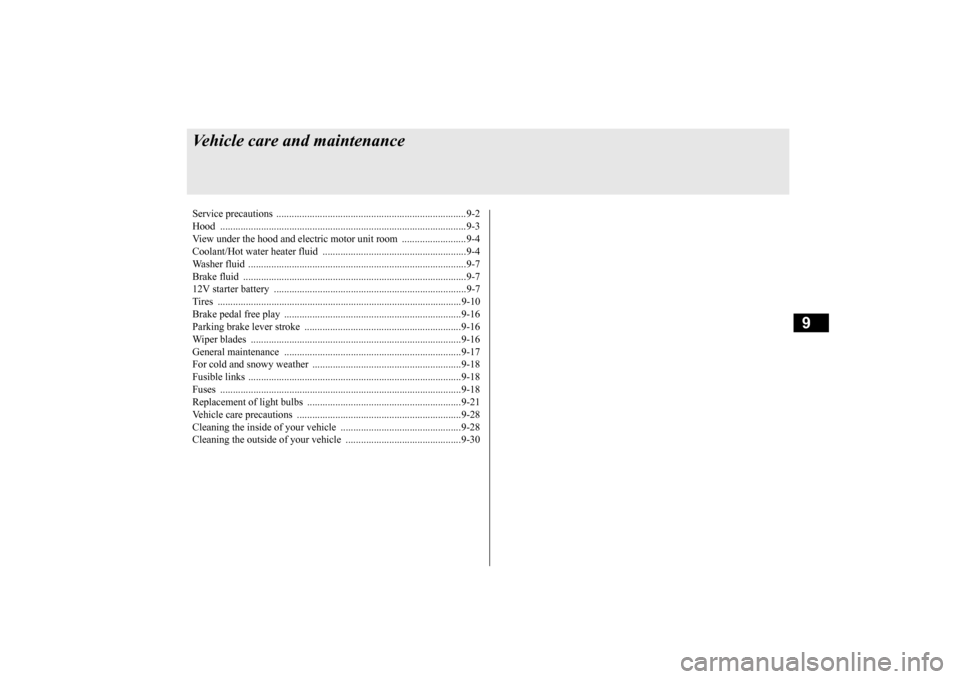
9
Vehicle care and maintenanceService precautions ..........................................................................9-2 Hood .............
............
...........
...........
...........
...........
...........
...........
.....9-3
View under the hood and electric motor unit room .........................9-4Coolant/Hot water heater fluid ........................................................9-4 Washer fluid .....................................................................................9-7 Brake fluid .......................................................................................9-712V starter battery ...........................................................................9-7 Tires ...............................................................................................9-10 Brake pedal free play .....................................................................9-16Parking brake lever stroke .............................................................9-16 Wiper blades ..................................................................................9-16 General maintenance .....................................................................9-17For cold and snowy weather ..........................................................9-18 Fusible links ...................................................................................9-18 Fuses ..............................................................................................9-18Replacement of light bulbs ............................................................9-21 Vehicle care precautions ................................................................9-28 Cleaning the inside of your vehicle .......
...........
...........
...........
.......9-28
Cleaning the outside of your vehicle .....
...........
...........
...........
.......9-30
BK0220401US.book 1 ページ 2015年6月3日 水曜日 午前7時42分
Page 249 of 296
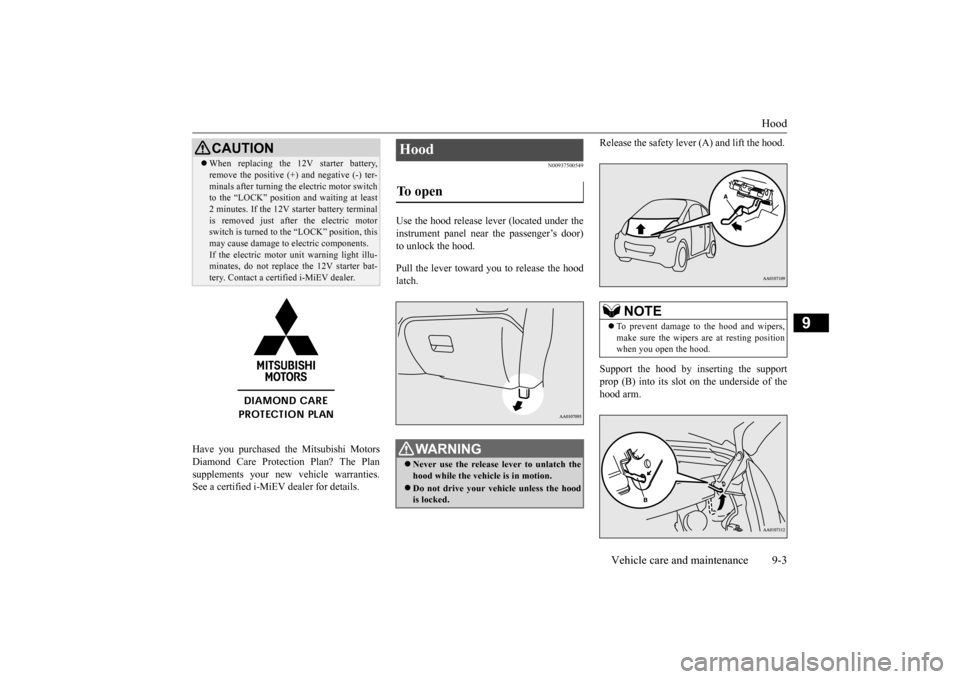
Hood
Vehicle care and maintenance 9-3
9
Have you purchased the Mitsubishi Motors Diamond Care Protec
tion Plan? The Plan
supplements your new
vehicle warranties.
See a certified i-MiEV dealer for details.
N00937500549
Use the hood release lever (located under the instrument panel near the passenger’s door) to unlock the hood. Pull the lever toward you to release the hood latch.
Release the safety leve
r (A) and lift the hood.
Support the hood by inserting the support prop (B) into its slot on the underside of the hood arm.
When replacing the
12V starter battery,
remove the positive (+
) and negative (-) ter-
minals after turning the electric motor switchto the “LOCK” position
and waiting at least
2 minutes. If the 12V st
arter battery terminal
is removed just after the electric motorswitch is turned to the “LOCK” position, this may cause damage to
electric components.
If the electric motor unit warning light illu-minates, do not replac
e the 12V starter bat-
tery. Contact a certified i-MiEV dealer.CAUTION
Hood To open
WA R N I N G Never use the release lever to unlatch the hood while the vehicle is in motion. Do not drive your vehicle unless the hood is locked.
NOTE
To prevent damage to the hood and wipers, make sure the wipers
are at resting position
when you open the hood.
BK0220401US.book 3 ページ 2015年6月3日 水曜日 午前7時42分
Page 250 of 296
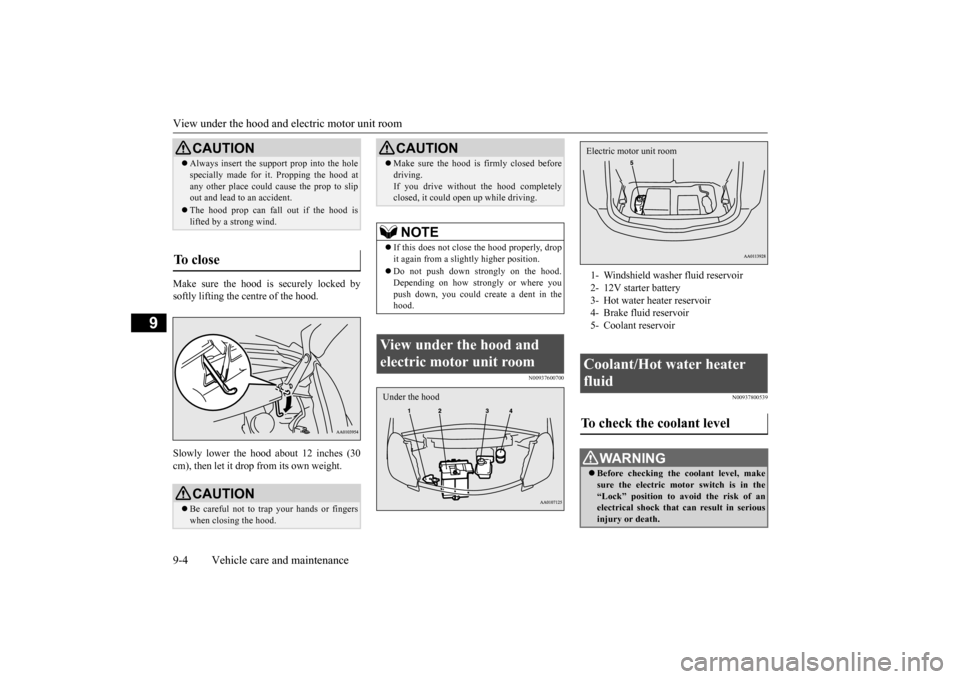
View under the hood and
electric motor unit room
9-4 Vehicle care and maintenance
9
Make sure the hood is securely locked by softly lifting the centre of the hood. Slowly lower the hood about 12 inches (30 cm), then let it drop from its own weight.
N00937600700
N00937800539
CAUTION Always insert the support prop into the hole specially made for
it. Propping the hood at
any other place could
cause the prop to slip
out and lead to
an accident.
The hood prop can fall out if the hood is lifted by a strong wind.
To close
CAUTION Be careful not to trap your hands or fingers when closing the hood.
Make sure the hood is firmly closed before driving.If you drive without the hood completelyclosed, it could open up while driving.NOTE
If this does not close the hood properly, drop it again from a slightly higher position. Do not push down strongly on the hood. Depending on how strongly or where you push down, you could create a dent in the hood.
View under the hood and electric motor unit room
CAUTION
Under the hood
1- Windshield washer fluid reservoir 2- 12V starter battery 3- Hot water heater reservoir 4- Brake fluid reservoir5- Coolant reservoirCoolant/Hot water heater fluid To check the coolant level
WA R N I N G Before checking the
coolant level, make
sure the electric motor switch is in the“Lock” position to
avoid the risk of an
electrical shock that can result in serious injury or death.Electric motor unit room
BK0220401US.book 4 ページ 2015年6月3日 水曜日 午前7時42分
Page 253 of 296
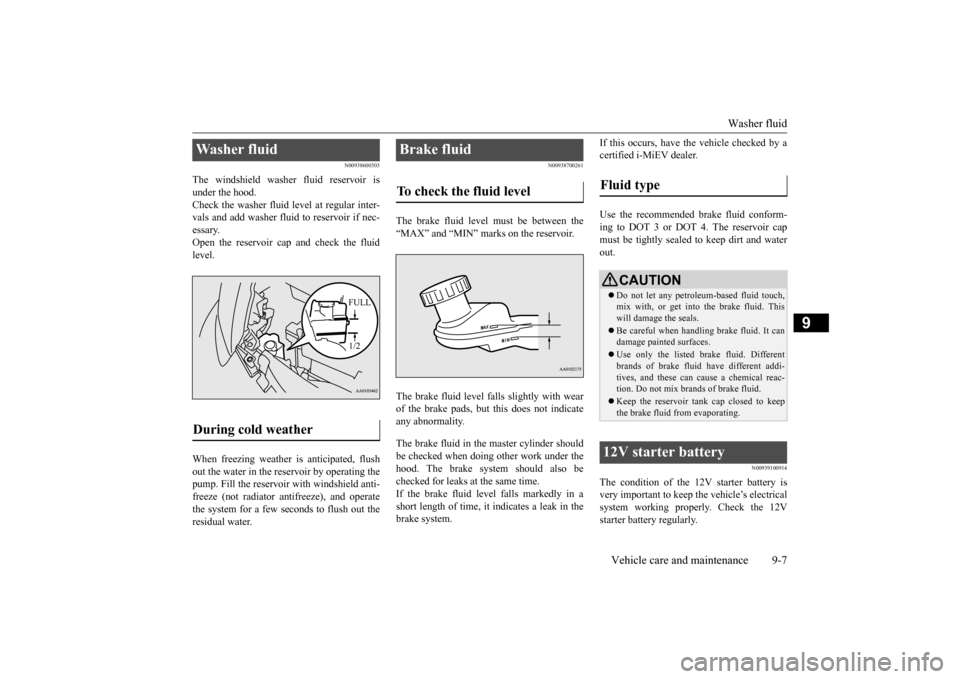
Washer fluid
Vehicle care and maintenance 9-7
9
N00938600303
The windshield washer fluid reservoir is under the hood. Check the washer fluid level at regular inter-vals and add washer fluid to reservoir if nec- essary. Open the reservoir cap and check the fluidlevel. When freezing weather is anticipated, flush out the water in the reservoir by operating the pump. Fill the reservoir with windshield anti-freeze (not radiator
antifreeze), and operate
the system for a few se
conds to flush out the
residual water.
N00938700261
The brake fluid level must be between the “MAX” and “MIN” marks on the reservoir. The brake fluid level fa
lls slightly with wear
of the brake pads, but
this does not indicate
any abnormality. The brake fluid in the master cylinder should be checked when doing other work under the hood. The brake system should also bechecked for leaks at the same time. If the brake fluid level falls markedly in a short length of time, it indicates a leak in thebrake system.
If this occurs, have the vehicle checked by a certified i-MiEV dealer. Use the recommended brake fluid conform- ing to DOT 3 or DOT 4. The reservoir capmust be tightly sealed
to keep dirt and water
out.
N00939100914
The condition of the 12V starter battery is very important to keep the vehicle’s electricalsystem working properly. Check the 12V starter battery regularly.
Washer fluid During cold weather
FULL 1/2
Brake fluid To check the fluid level
Fluid type
CAUTION Do not let any petrol
eum-based fluid touch,
mix with, or get into the brake fluid. This will damage the seals. Be careful when handling brake fluid. It can damage painted surfaces. Use only the listed brake fluid. Different brands of brake fluid have different addi-tives, and these can cause a chemical reac- tion. Do not mix brands of brake fluid. Keep the reservoir ta
nk cap closed to keep
the brake fluid from evaporating.
12V starter battery
BK0220401US.book 7 ページ 2015年6月3日 水曜日 午前7時42分
Page 257 of 296
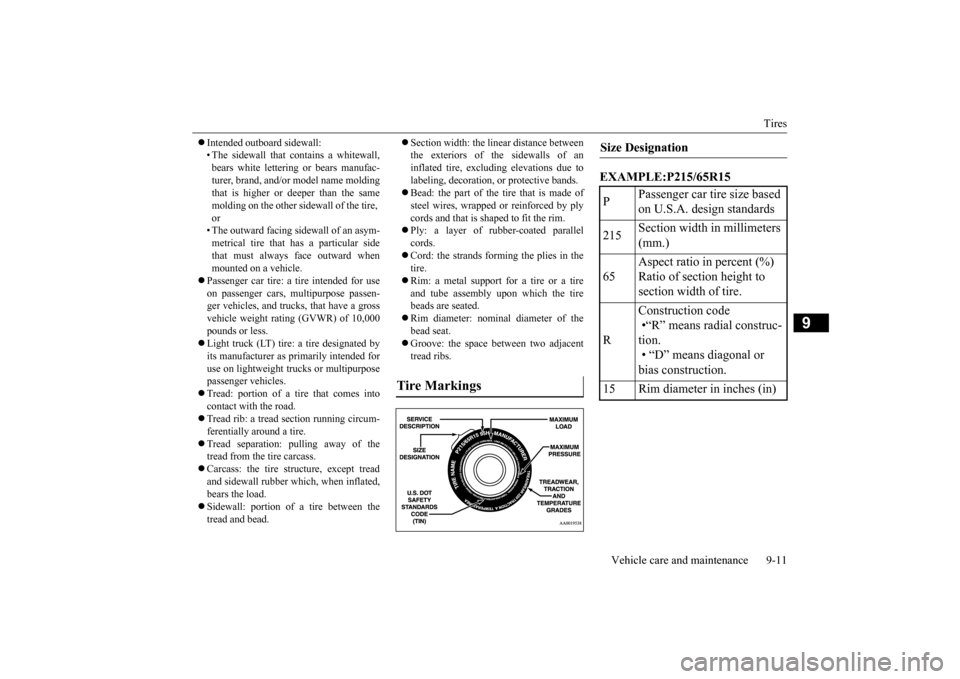
Tires
Vehicle care and maintenance 9-11
9
Intended outboard sidewall: • The sidewall that c
ontains a whitewall,
bears white letteri
ng or bears manufac-
turer, brand, and/or model name molding that is higher or deeper than the samemolding on the other sidewall of the tire, or • The outward facing si
dewall of an asym-
metrical tire that has a particular side that must always face outward when mounted on a vehicle.
Passenger car tire: a
tire intended for use
on passenger cars, multipurpose passen-ger vehicles, and trucks, that have a gross vehicle weight rati
ng (GVWR) of 10,000
pounds or less. Light truck (LT) tire: a tire designated by its manufacturer as primarily intended for use on lightweight truc
ks or multipurpose
passenger vehicles. Tread: portion of a tire that comes into contact with the road. Tread rib: a tread se
ction running circum-
ferentially around a tire. Tread separation: pulling away of the tread from the tire carcass. Carcass: the tire structure, except tread and sidewall rubber which, when inflated,bears the load. Sidewall: portion of
a tire between the
tread and bead.
Section width: the line
ar distance between
the exteriors of the sidewalls of aninflated tire, excluding elevations due to labeling, decoration, or protective bands. Bead: the part of the tire that is made of steel wires, wrapped
or reinforced by ply
cords and that is shaped to fit the rim. Ply: a layer of rubber-coated parallel cords. Cord: the strands forming the plies in the tire. Rim: a metal support for a tire or a tire and tube assembly upon which the tirebeads are seated. Rim diameter: nominal diameter of the bead seat. Groove: the space between two adjacent tread ribs.
EXAMPLE:P215/65R15
Tire Markings
Size Designation P
Passenger car tire size based on U.S.A. design standards
215
Section width in millimeters (mm.)
65
Aspect ratio in percent (%) Ratio of section height to section width of tire.
R
Construction code •“R” means radial construc- tion.
• “D” means diagonal or bias construction.
15 Rim diameter in inches (in)
BK0220401US.book 11 ページ 2015年6月3日 水曜日 午前7時42分
Page 258 of 296
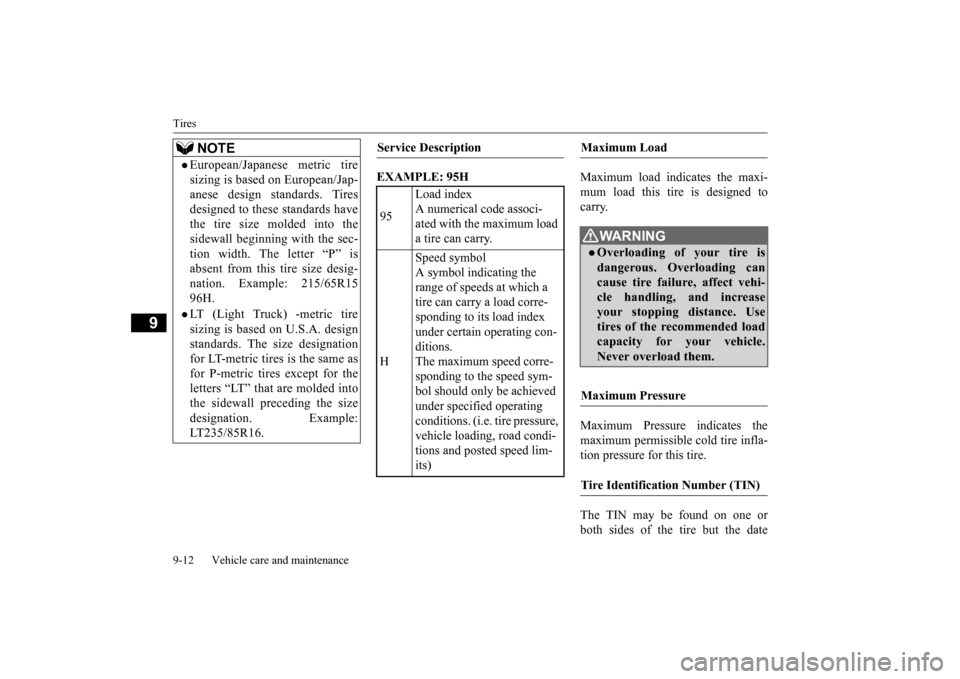
Tires 9-12 Vehicle care and maintenance
9
EXAMPLE: 95H
Maximum load indicates the maxi- mum load this tire is designed to carry. Maximum Pressure indicates the maximum permissible cold tire infla-tion pressure for this tire. The TIN may be found on one or both sides of the tire but the date
NOTE
European/Japanese metric tire sizing is based on European/Jap- anese design standards. Tires designed to these standards havethe tire size molded into the sidewall beginning with the sec- tion width. The letter “P” isabsent from this tire size desig- nation. Example: 215/65R15 96H.LT (Light Truck) -metric tiresizing is based on U.S.A. designstandards. The size designation for LT-metric tires is the same as for P-metric tires except for theletters “LT” that are molded into the sidewall preceding the size designation. Example:LT235/85R16.
Service Description 95
Load index A numerical code associ- ated with the maximum load a tire can carry.
H
Speed symbol A symbol indicating the range of speeds at which a tire can carry a load corre- sponding to its
load index
under certain operating con-ditions.The maximum speed corre- sponding to the speed sym- bol should only be achieved under specified operating conditions. (i.e. tire pressure, vehicle loading, road condi-tions and posted speed lim- its)
WA R N I N GOverloading of your tire is dangerous. Overloading cancause tire failure, affect vehi- cle handling, and increase your stopping distance. Usetires of the recommended load capacity for your vehicle. Never overload them.
Maximum Pressure Tire Identification Number (TIN)
BK0220401US.book 12 ページ 2015年6月3日 水曜日 午前7時42分
Page 264 of 296
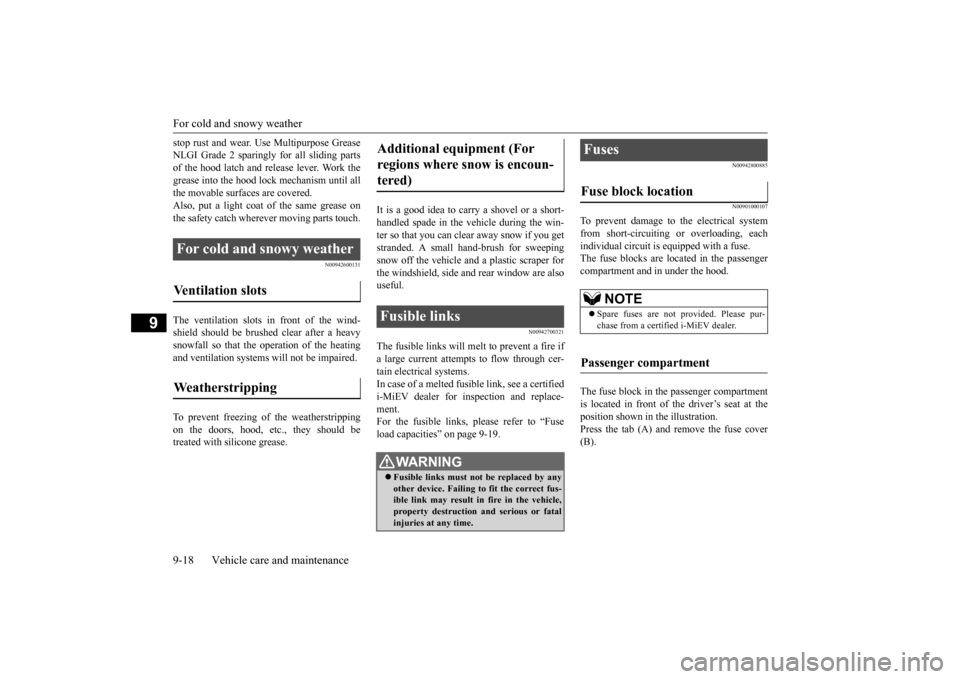
For cold and snowy weather 9-18 Vehicle care and maintenance
9
stop rust and wear. Us
e Multipurpose Grease
NLGI Grade 2 sparingly for all sliding partsof the hood latch and release lever. Work the grease into the hood lock mechanism until all the movable surfaces are covered.Also, put a light coat
of the same grease on
the safety catch wherever moving parts touch.
N00942600131
The ventilation slots in
front of the wind-
shield should be brushed clear after a heavysnowfall so that the operation of the heating and ventilation
systems will not be impaired.
To prevent freezing of the weatherstripping on the doors, hood, etc., they should be treated with silicone grease.
It is a good idea to carry a shovel or a short- handled spade in the vehicle during the win- ter so that you can clear away snow if you get stranded. A small hand-brush for sweepingsnow off the vehicle a
nd a plastic scraper for
the windshield, side a
nd rear window are also
useful.
N00942700321
The fusible links will melt to prevent a fire ifa large current attempts to flow through cer- tain electrical systems. In case of a melted fusi
ble link, see a certified
i-MiEV dealer for in
spection and replace-
ment. For the fusible links, please refer to “Fuseload capacities” on page 9-19.
N00942800885 N00901000107
To prevent damage to the electrical system from short-circuiting
or overloading, each
individual circui
t is equipped with a fuse.
The fuse blocks are lo
cated in the passenger
compartment and in under the hood. The fuse block in the
passenger compartment
is located in front of the driver’s seat at theposition shown in the illustration. Press the tab (A) and remove the fuse cover (B).
For cold and snowy weather Ventilation slots Weatherstripping
Additional equipment (For regions where snow is encoun-tered) Fusible links
WA R N I N G Fusible links must not be replaced by any other device. Failing to fit the correct fus- ible link may result in fire in the vehicle, property destruction and serious or fatalinjuries at any time.
Fuses Fuse block location
NOTE
Spare fuses are not provided. Please pur- chase from a certified i-MiEV dealer.
Passenger compartment
BK0220401US.book 18 ページ 2015年6月3日 水曜日 午前7時42分